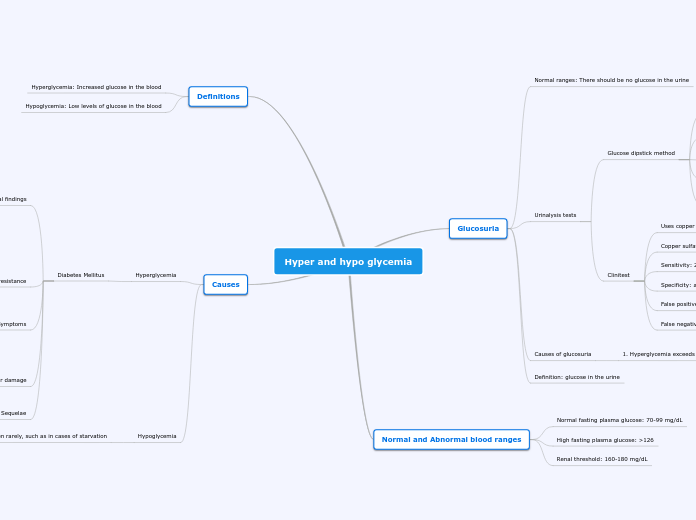Hyper and hypo glycemia
Glucosuria
Normal ranges: There should be no glucose in the urine
Urinalysis tests
Glucose dipstick method
Specific for glucose
Uses glucose oxidase, which produces peroxide
Peroxide reacts with chromogen, catalyzed by peroxidase, to produce oxidized chromogen
The oxidized chromogen causes a color change
Sensitivity: 75-125 mg/dL
False positives: strong oxidizing agents and peroxides
False Negatives: ascorbic acid or improperly stored urine (glycolysis)
Clinitest
Uses copper reduction to detect any reducing substance
Copper sulfate is reduced to cuprous oxide
Sensitivity: 250 mg/dL
Specificity: all reducing substances
False positive: Any reducing substance, such as ascorbic acid
False negative: bleach or radiographic dye
Causes of glucosuria
1. Hyperglycemia exceeds renal threshold
2. Renal threshold is lower than normal, such as in renal glycosuria
Definition: glucose in the urine
Normal and Abnormal blood ranges
Normal fasting plasma glucose: 70-99 mg/dL
High fasting plasma glucose: >126
Renal threshold: 160-180 mg/dL
Definitions
Hyperglycemia: Increased glucose in the blood
Hypoglycemia: Low levels of glucose in the blood
Causes
Hyperglycemia
Diabetes Mellitus
Clinical findings
glycosuria
hyperglycemia
proteinuria
hypotonic urine
low urine specific gravity
ketonuria
electrolyte imbalance
Caused by insulin deficiency or resistance
Symptoms
polyuria
polydipsia
polyphasigia
microvascular damage
Diabetic nephropathy
Presents as a glomerular syndrome
Thickening of glomerular basement membrane
allows protein to leak through
Susceptible to pyelonephritis and papillary necrosis
Sequelae
Macrovascular damage
Hypoglycemia
Seen rarely, such as in cases of starvation
